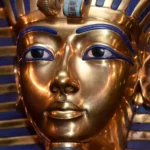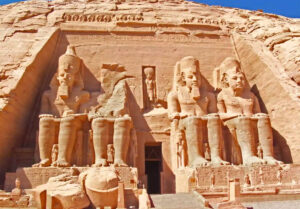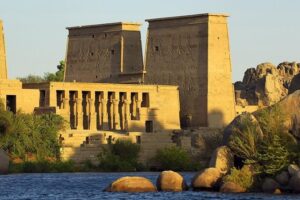The Great Sphinx is the biggest man-made ancient statue ever created on earth for Pharaoh Khafre in 2600 BC. It was carved from a single limestone block to possess the wisdom in its looks and power in its figures.
The Great Sphinx: An Enduring Icon of Ancient Might and Mystery
The Great Sphinx of Giza stands as an unparalleled testament to ancient Egyptian ingenuity. This colossal monument captures the imagination of all who behold it. It remains the largest ancient statue ever carved from a single block of stone on Earth.

A Monument to Pharaoh Khafre
Pharaoh Khafre ordered its creation around 2600 BC. This makes the Sphinx a contemporary of the Second Pyramid at Giza, which also belongs to Khafre. Ancient Egyptians specifically built the Sphinx to guard Khafre’s pyramid complex. It faces directly east, welcoming the rising sun.
Carved from a Single Stone: An Engineering Marvel
What truly sets the Sphinx apart is its construction. Artisans carved this monumental statue directly from a massive limestone bedrock outcrop. This single, immense block forms its entire body. Such a feat of engineering and artistry speaks volumes about the capabilities of ancient Egyptian civilization. The sheer scale and precision of the carving are astounding.
The Great Sphinx’s Symbolism
The Sphinx’s unique form perfectly embodies ancient Egyptian beliefs. Specifically, its human head represents wisdom and intellect. Many scholars believe this head depicts Pharaoh Khafre himself. Furthermore, the powerful lion’s body symbolizes immense strength, royalty, and protection. Consequently, these elements together conveyed the pharaoh’s divine wisdom and his formidable power over the land.
Unveiling Ancient Secrets
For centuries, the Sphinx lay buried up to its shoulders in desert sands. However, modern archaeology has now fully uncovered it, revealing its full grandeur. Even today, the Great Sphinx poses many questions. Indeed, its exact purpose, original name, and the subtle nuances of its symbolism continue to intrigue historians and archaeologists alike.
The Great Sphinx truly offers a powerful connection to ancient Egypt. Ultimately, it remains a monumental symbol of their enduring legacy, inviting visitors to ponder its silent wisdom and timeless power.
Weird Theories About the Great Sphinx: Beyond the Conventional
The Great Sphinx of Giza, with its enigmatic gaze, has captivated humanity for millennia. While archaeologists offer conventional explanations for its purpose and age, countless unusual and even bizarre theories have emerged over the centuries. These theories often stray far from mainstream Egyptology, yet they continue to fuel fascination and debate. Here are some of the most prominent weird theories about the Sphinx:

1. The “Water Erosion” Theory: An Older, Wetter Sphinx
What it suggests: This theory claims the Sphinx is much, much older than conventionally believed – tens of thousands of years old, predating the pharaohs. Proponents, most notably John Anthony West and geologist Robert Schoch, argue that the erosion patterns on the Sphinx and its enclosure walls are consistent with prolonged rainfall and water runoff, not just wind and sand. They point to evidence of “undercutting” and vertical fissures that they believe are typical of water erosion.
Why it’s weird (to mainstream): Mainstream geology and Egyptology largely attribute the erosion to millennia of wind, sand, and changes in the water table, along with human activity. A date of 10,000 BC or earlier would push the Sphinx’s creation back to a time when complex civilizations, capable of such monumental architecture, are not believed to have existed.
2. The “Hall of Records” Theory: Secret Chambers Beneath
What it suggests: This popular theory posits that a hidden chamber, known as the “Hall of Records,” lies beneath the Sphinx, containing ancient knowledge, artifacts, and possibly even proof of a lost civilization or extraterrestrial contact. Edgar Cayce, a famous American psychic, popularized this theory, claiming the Hall of Records holds the history of Atlantis.
Why it’s weird: Despite numerous archaeological surveys using ground-penetrating radar and other non-invasive techniques, no conclusive evidence of a large, hidden chamber or “Hall of Records” has ever been found that aligns with these speculative claims. Small, natural fissures and minor cavities exist, but nothing resembling a grand archive.
3. Extraterrestrial Connection: Aliens Built the Sphinx
What it suggests: For some, the sheer scale and precision of the Sphinx, along with other monumental ancient structures, are too advanced for ancient human capabilities. Therefore, they propose that extraterrestrial beings either directly built the Sphinx or provided advanced technology and knowledge to the ancient Egyptians.
Why it’s weird: This theory dismisses the known capabilities and ingenuity of ancient Egyptian engineers, astronomers, and laborers. Instead, it attributes their achievements to external, unproven forces. Conversely, mainstream archaeology finds ample evidence of human planning, tools, and organization for the construction of these monuments.
4. The Sphinx as a Portal or Energy Machine
What it suggests: Some theories propose that the Sphinx is not merely a statue but a device with a deeper, perhaps energetic or spiritual purpose. This could involve it being a cosmic “tuning fork,” a gateway to other dimensions, or a receiver/transmitter of planetary energy.
Why it’s weird: These theories venture into pseudoscientific or spiritual realms without any empirical evidence or grounding in archaeological findings. They often draw on New Age philosophies rather than historical or scientific data.
5. It’s Not a Lion: Other Animal Forms
What it suggests: While widely accepted as a lion’s body, some alternative theories propose that the Sphinx was originally a different animal, such as an Anubis (jackal) or even a dog. The head was then re-carved later.
Why it’s weird: Archaeological context and ancient Egyptian symbolism strongly support the leonine form; lions represented royalty and protective power. While builders sometimes altered ancient structures, changing the entire animal form constitutes a significant and unsupported claim.
6. The Sphinx as an Astronomical Marker
What it suggests: While the Sphinx’s east-facing orientation aligns with the rising sun, some theories go further, claiming it functions as a precise astronomical clock or calendar, pointing to specific constellations (like Leo, given its body) at particular cosmic junctures.
Why it’s weird (to mainstream extent): While ancient Egyptians certainly used astronomy, and major temples aligned astronomically, specific claims about the Sphinx acting as a complex, multi-functional astronomical device beyond its general orientation often lack concrete evidence and rely on speculative interpretations.
Why Do These Theories Persist?
The enduring mystery of the Sphinx, coupled with the awe it inspires, creates fertile ground for unconventional theories. Its age, its silent gaze, and the sheer effort involved in its creation lead many to seek explanations beyond the conventional. While Egyptologists continue to uncover evidence through rigorous scientific methods, these weird theories serve as a testament to humanity’s endless fascination with the ancient world and the unknown.
If you want to tour the pyramids and the Sphinx, before you go, check Egypt’s weather.











